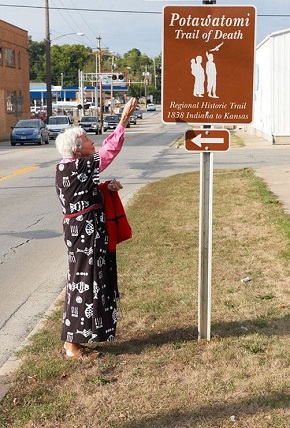 Since first taking the road in 1988, the Potawatomi Trail of Death Caravan has tried to give attendees a small sense of the extensive landscape covered by the Indian Potawatomi on the Trail of Death in 1838. Crossing four states on a forced march lead by American soldiers, the Potawatomi of the time traversed the still largely wild lands of Indian, Illinois, and Missouri before their stop in Sugar Creek, Kansas.
Since first taking the road in 1988, the Potawatomi Trail of Death Caravan has tried to give attendees a small sense of the extensive landscape covered by the Indian Potawatomi on the Trail of Death in 1838. Crossing four states on a forced march lead by American soldiers, the Potawatomi of the time traversed the still largely wild lands of Indian, Illinois, and Missouri before their stop in Sugar Creek, Kansas.
There were few markers in 1988 to show the trail, but over the years descendants of the tribe as well as the Potawatomi Trail of Death Association have helped mark stopping points along the way. According to Potawatomi Trail of Death Association Treasurer and Fulton County Indiana Historian Shirley Willard, there are more than 80 historical markers and 150 historical highway signs along the trail, all paid for through donations by volunteers.
“I worked with the Potawatomi for more than 30 years to commemorate and mark the 1838 Trail of Death from Indiana to Kansas. It is one of the best marked historic trails in the world,” said Willard in a press release.
Though less well known than the more famous Trail of Tears of the Cherokee Nation, the experiences of the Trail of Death are etched in the history of the tribe that is today known as the Citizen Potawatomi Nation. The deaths of 42 Potawatomi along the 660 mile forced march, which lasted two months in cold fall weather in 1838, remain poignant reminders of the lethal nature of the journey.
After the most recent caravan in 2013, Willard and other volunteer members of the Potawatomi Trail of Death Association, including many Citizen Potawatomi, began working with YourStory Digital Productions on a documentary commemorating its memory. Directed by Susan Green and narrated by Willard, the documentary reveals the story of the Potawatomi on the trail according to journal entries kept by participants and later recollections. The film also intersperses interviews with living Citizen Potawatomi Nation members who were in attendance at the 2013 caravan ceremony which culminated in a stop at the former Sugar Creek reservation in eastern Kansas.
Descendants of the Trail of Death retrace their journey, discover long held memories from folks along the way and receive unexpected receptions as they stop at each original campsite. Potawatomi participants include Bill Wamego and family, George Godfrey, Sister Virginia Pearl, Bob Pearl, Jon Boursaw, Tom Hamilton, Susan Campbell, Tracy and Erin Locke, and others. The documentary’s trailer can be viewed at Facebook.com/LikeBirdsinaWindStorm.
The film is available for purchase by the public. To order a copy for $15, send a check to Potawatomi Trail of Death Association, c/o Shirley Willard, 3063 S 425 E, Rochester IN 46975.
Libraries, schools and museums in Indiana are also set to receive free copies of the documentary while supplies last. To learn more about the Potawatomi Trail of Death, visit www.potawatomi.org/culture/trail-of-death, www.potawatomitda.org or potawatomiheritage.org.
